Whether you’re a fan of real time strategy, first person shooters, or turn based tactics, 40k fans are spoiled for choice when it comes to videogames. These are the best Warhammer 40k games that you can play right now, from recent releases to retro classics.
Just like the tabletop game that inspired them, Warhammer 40k computer games often have a tactical slant: you’ll find some of these titles on our guides to the best RTS games and best games like XCOM. But this list is genre agnostic, and there are almost as many games for action fans as there are for strategy boffs. Everything on this list has been tested by the Wargamer team, and is recommended because we rate it.
The best Warhammer 40k games are:

Rogue Trader (2023)
Owlcat Games
No other game captures the immense scale of the Warhammer 40k universe like Rogue Trader. This isometric, party-based CRPG puts you in charge of a city-sized spaceship, and tasks you with building your own dynasty among the stars in a subsector ravaged by warpstorms.
Your custom character is one potential successor to a veteran Rogue Trader, a space-faring merchant queen with a divine mandate to expand the borders of the Imperium through trade and conquest. You won’t wait in the wings for long, though – treachery and Chaos plots put your forebear out of the picture and you into the Captain’s throne soon enough.
The adventure that follows will take you at least 100 hours to complete. To begin with, you’ll be concerned with getting your city-sized void-ship into peak running order. But beyond that you have the conspiracy of your predecessor’s murder to unravel, trade deals to broker, adventures tied to your NPC companions’ backstories, and an empire to build.

A gamut of systems have been put in place to reflect your status as a profoundly wealthy and powerful individual. Building your trade Empire sometimes happens in story beats, like main-story-missions to make contact with lost worlds and kick their planetary governors into line. But there’s a lightweight colony management minigame, in which you’ll found settlements, extract resources from them, and shape their development as crises arrive.
Combat happens both in the void of space and in head to head ground fights. The ground combat is particularly visceral, enhanced by appropriately cacaphonic audio design for iconic weapons like the boltgun and chainsword. It’s enjoyably deep, too, with as many technical options to manipulate the battlefield and layer buffs and debuffs as there are OTT weapons.
To realise a game on this scale, developer Owlcat limited the scope in some areas. Rogue Trader’s graphics are effective but unexceptional. The game launched with plenty of bugs, though these have mostly been squashed. It takes a traditional approach of thoroughly separating combat, dialogue, and exploration, and the environments are mostly set-dressing compared to the interactive arenas of Baldur’s Gate 3.
But the heart and soul of the game is spot on. Rogue Trader has thousands of lines of dialogue, and the narrative leads absolutely get Warhammer 40k – the horror, inhumanity, and pathos of the Imperium of Man. This shines through particularly well in your NPC companions, who are written to be believably human, yet distinctively alien.
For more thoughts, check out Wargamer’s Rogue Trader review.

Boltgun (2023)
Auroch Digital / Focus Entertainment
If you want to feel like an unstoppable juggernaut of destruction, play Boltgun. A first person shooter inspired by early FPS games like Quake and Doom, it’s a game in which you go fast and shoot hordes of enemies into teeny tiny bits.
The retro graphics, with sprite-based enemies and low-poly 3D arenas, are a mission statement: this is a pure retro FPS experience. Wearing the big stompy boots of Ultramarines Sternguard veteran Malum Caedo, you’ll blast, jump, and chainsword your way through thousands of the followers of Chaos.
You’re here to shoot stuff, and boy does shooting stuff feel great. The game’s armory is realised with loving care and attention. They’re lovingly realised as pixel models, but the audio feedback is where they really shin. The meltagun roars like Cerberus, the heavy bolter thunders like an industrial press, and destroyed enemies come apart with a sound like a beef carcass being thrown into an industrial fan.

It’s not just vibes, though – there’s surprising tactical depth behind your choice of weapons. Just like the tabletop game, weapons have a Strength score and enemies a Toughness score – you’ll do only marginal damage if you attempt to hit a baddy with an outclassed weapon. Each enemy has a distinctive role in combat, from the hindering nuisance of the Nurglings to the killer deathrays of a Lord of Change.
While the graphics are simple, the level design is excellent, both visually and as combat arenas. Colossal forge complexes, Chaos transdimensional gateways, and the warped interior of a corrupted space-ship represent the massive scale of 40k beautifully – though an in-game map would have been very helpful on some of the more sprawling levels.
You get to explore those locations at high speed, with some movement conveniences that the Doomslayer and Mr Quake never had access to in the ’90s. An automatic ledge grab and mantle climb make jumping a little easier; the bullrush charge lets you close rapidly on distant shooters and splat smaller foes entirely; and your chainsaw attack can help you clear even greater distancers by pulling you magnetically towards your target.
Check out our full Warhammer 40k Boltgun review to learn more!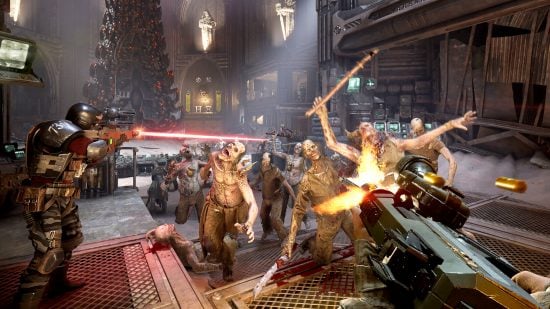
Darktide (2022)
Fatshark
If you’re a fan of both co-op multiplayer FPS games and Games Workshop’s grim, dark, bloodstained far future, Darktide will blow your mind (especially when playing as the psyker character, who can literally blow enemies’ minds by exploding their heads with concentrated warp energy).
Warhammer 40k Darktide is effectively a 40k-flavored reincarnation of its bestselling co-op slash-em-up Vermintide 2, which was based in the Old World fantasy setting. You play a ‘reject’ part of an Imperial Inquisitor’s warband, completing various missions in a hive city that’s overrun with servants of the Chaos god Nurgle.
Each of the Darktide classes offers a different core ability and playstyle, its own variety of guns, armor, and wargear, and a different library of conversational voice lines that’ll play out in procedurally generated conversations between the characters as you fight through waves of chaos-warped enemies, complete challenges, and fight disgusting bosses.
The voice lines can start to grate a little over time, but there’s enough variety that it still works well (and it helps that the voice acting and writing are both excellent, with superstar Black Library and Horus Heresy book author Dan Abnett on the team).

The game’s environments are frequently stunning, and an impressively faithful, atmospheric rendering of 40k’s unique aesthetics. You’ll be fighting through the spires and flying buttresses of futuristic gothic rooftops one mission, and trudging through oppressive, grimy industrial undercities the next. It’s by far the best visual simulation of the Warhammer 40k world we’ve seen in a videogame.
Darktide had a rocky launch, with a host of performance and connection issues that have taken a long time for the small studio to fix – which seems to have delayed plans for a series of post-launch content and story expansions. That, combined with a lack of variety in the high-level gear available, led to fans crying out for a better end-game experience to keep them playing.
That’s been tidied up nicely, with patches delivering performance upgrades and far richer content – Darktide patch 13 really turned things around.
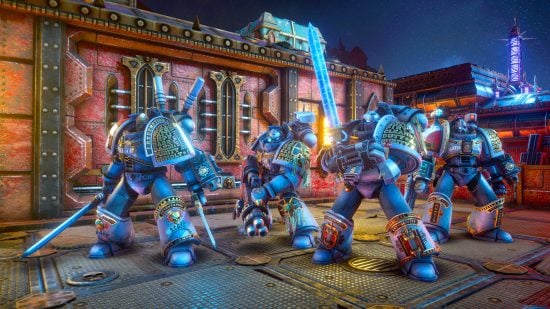
Chaos Gate Daemonhunters (2022)
Complex Games / Frontier Developments
Warhammer 40k Chaos Gate Daemonhunters just steals the crown from Mechanicus as the best game like XCOM set in the 40k universe. In Daemonhunters, you take command of a strike force of Grey Knights – elite, secretive chapter of Space Marines that are all psykers, and use their psychic might and advanced wargear to combat incursions by Chaos Daemons.
You’ll build a base, train and equip a team of soldiers, and deploy them on various missions to hold back an oncoming, apocalyptic threat – a new, deadly galactic plague cooked up by the Chaos god Nurgle.
The various different classes of Grey Knights available for your roster (as well as the Duty Eternal DLC’s Venerable Dreadnought and Imperial Assassins in the Execution Force expansion) each offer different skill trees to upgrade and specialise throughout the game – so long as you keep them alive.
Combine that with a ton of unlockable weapons and wargear items, plus cosmetic customisation options coming out the wazoo, and you’ve got a ‘war-barbie’ experience second only to collecting and painting miniatures in real life.

Like others in the genre, Chaos Gate Daemonhunters’ race-against-time campaign is a tough strategic challenge, forcing you to manage limited resources and prioritise your missions carefully against a stronger, better-resourced, ever-growing opponent – and the turn-based tactical battles are no cake walk either.
In a twist on the XCOM DNA, your superhuman Space Marines’ shots will always hit their target (no soul-crushing percentage hit chances here) and you’re given a lot of handy contextual information to inform your tactics, including advance notice of how much damage your shots will deal out from a given movement destination, before you make that move.
On the other hand, every few turns, you’ll hit a Warp Surge – granting your Nurgle-loving enemies a random chaos boon, ranging from temporary damage boosts to mid-game reinforcements joining the battle. Every mission is a potentially punishing battle that rewards quick thinking, aggressive tactics, and canny use of specialists’ abilities; it’s excellently done.
Like XCOM 2 before it, Daemonhunters can be an exhaustingly intense experience, where losses are all but inevitable, and often crushing – but the blend of strategy and tactics is on point, the core gameplay is very satisfying, and the Warhammer 40k lore background well realised. If you like both XCOM and Warhammer, this is essential.
For full details, see our Warhammer 40k Chaos Gate Daemonhunters review.
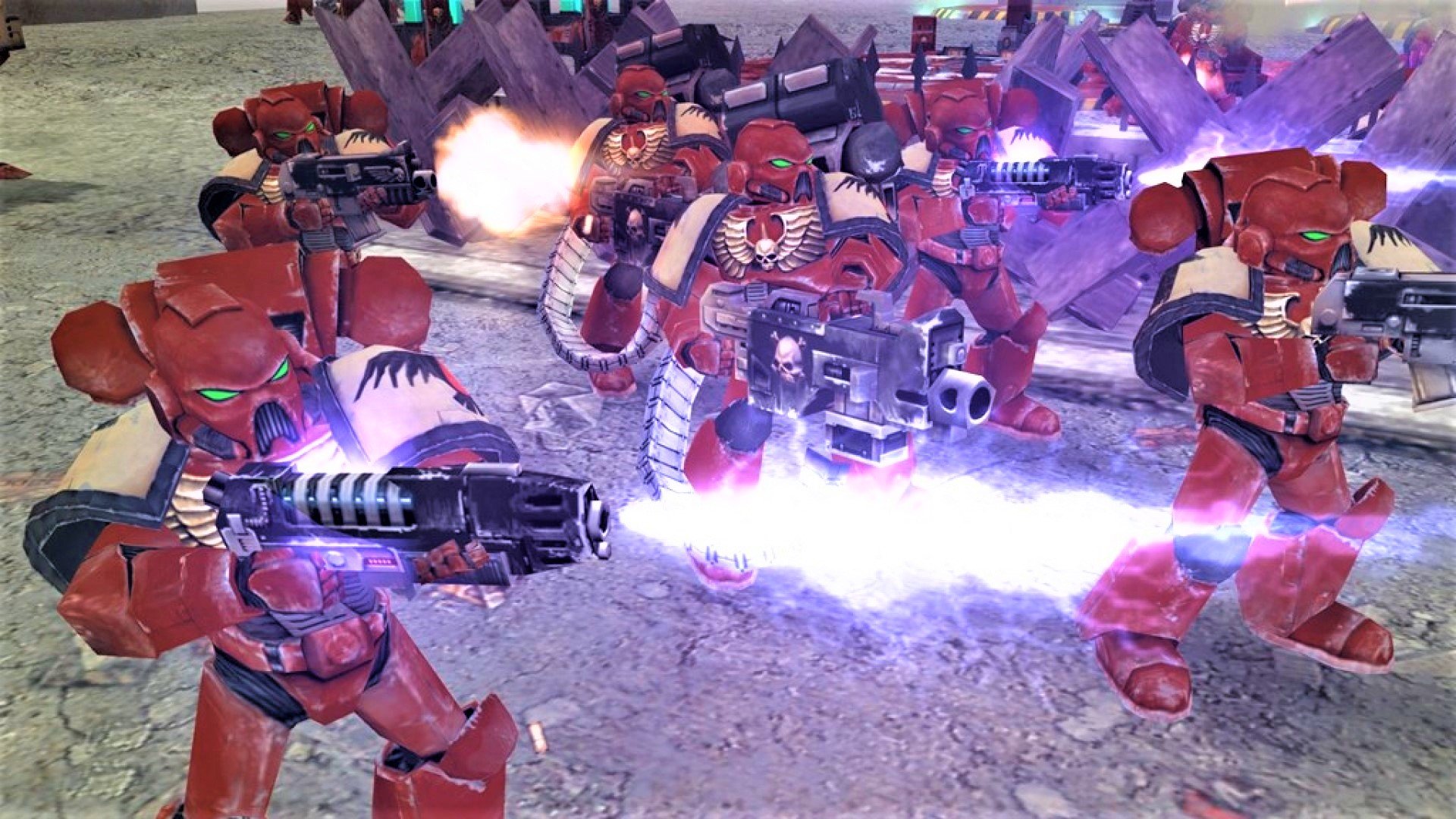
Dawn of War (2004)
Relic Entertainment / THQ
Back to the classics now: 2004’s Dawn of War is a giant which still stands up as one of the best RTS games ever made. Though it pioneered many concepts that would drive the RTS genre forwards, it remains rooted in the base-building RTS era.
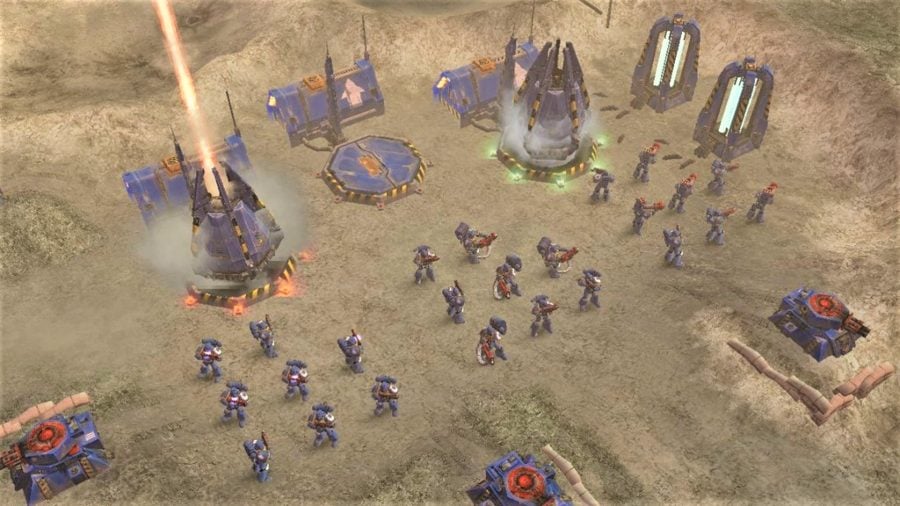
Developer Relic struck gold by simplifying and streamlining many classic RTS mechanics. Each click produces a neat squad of infantry, not individual figures that have to be cursor-lassoed together. Resources come from taking and holding battlefield strongpoints, not faffing with ancillary farmer units.
Base-building is lightweight, strongly focused on unlocking military units and upgrades. This game, like its tabletop counterpart, wanted you to leave the admin at home, get out there, and make war.
More importantly than all of that, it got the feel right. Dawn of War has just enough lore-appropriate flavour to sate players with a shelf full of lovingly painted Dark Angels right above their monitor, but not so much as to confuse others, or bog down the game’s inherent strengths as a fast-paced, aggressive RTS.

These days, with this venerable title now old enough to drive a car and enlist in the US army, we know we’re viewing it through slightly rose-tinted helm-lenses.
But with a rock-solid gameplay foundation, a satisfying, authentic 40K storyline, and a suite of blockbuster expansions, we can confidently say Dawn of War is a stunner – easily a contender for the finest Warhammer computer game of them all.
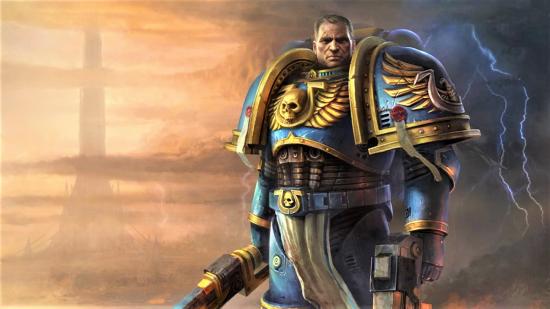
Space Marine (2011)
Relic Entertainment / THQ
Warhammer 40,000: Space Marine, the epic, gore-drenched odyssey of Ultramarines Captain Titus achieves something Warhammer computer games almost never can: it actually makes us care about its main character. Not that this is a complicated tale – you go to a human factory planet besieged by Orks, kill thousands of Orks, realise it was Chaos’ nefarious doing all along, kill the Chaos leader, the end, then it’s straight home for tea and nutrient paste.
No, we care about Titus because he’s the most impressively realised, most relatable and believable Space Marine warrior ever in a videogame, and, by placing us in his massive ceramite boots, this game gets closer than any other to recreating on screen the peculiarly gripping power fantasy of being a transhuman Astartes warrior.
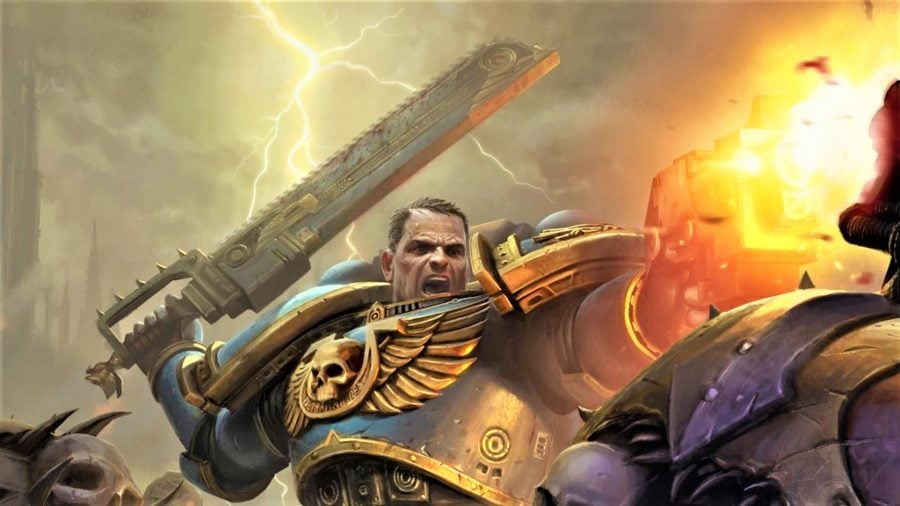
Titus’ 8-foot-tall, 6-foot-wide bulk towers over human-sized NPCs and scampering greenskin enemies alike, making you feel like one of the magnificent gods of war so reverently described in Black Library novels. Every decibel of his voice – the inimitable and perfect booming tones of Mark Strong – projects the grave, dutiful assiduousness of an Ultramarine.
His every animated step, lunge, swing and leap is perfectly tuned to feel impossibly powerful and weighty, conveying an uncanny sense of superhuman heaviness that makes Gears of War seem a bouncy, air-filled platformer by comparison.
The game’s atmosphere is treacle-thick, bloody, and intoxicatingly 40K. While the environments are an endless succession of near-identical corpse-strewn industrial zones, it really doesn’t matter, because all you’ll care about is the banging of your boltgun’s explosive shells and the rhythmic roar of your chainsword swinging up and down, carving Orks into green-and-red jelly.
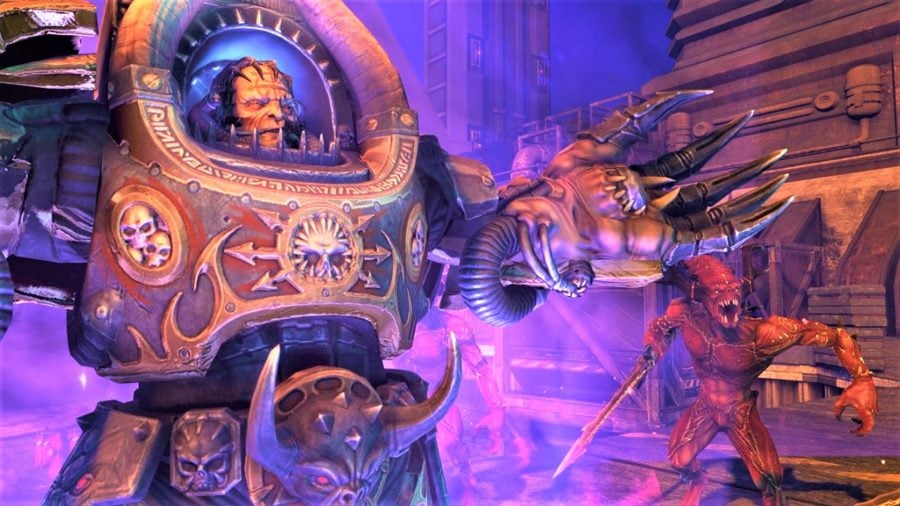
Space Marine – also by Relic Entertainment, and available on PC and console still – is required gaming for 40K fans because, more than any other title, it gets, on a deep level, the particular escapism baked into Games Workshop’s pre-eminent sci-fi ‘heroes’ – gigantic shoulder pads and all.
That is, until the Space Marine 2 release date this September, which – from our time with the preview build – we think is going to blow the original out of the water. We’re busily compiling everything we’ve seen there and in the trailers to pre-populate a Space marine 2 walkthrough...
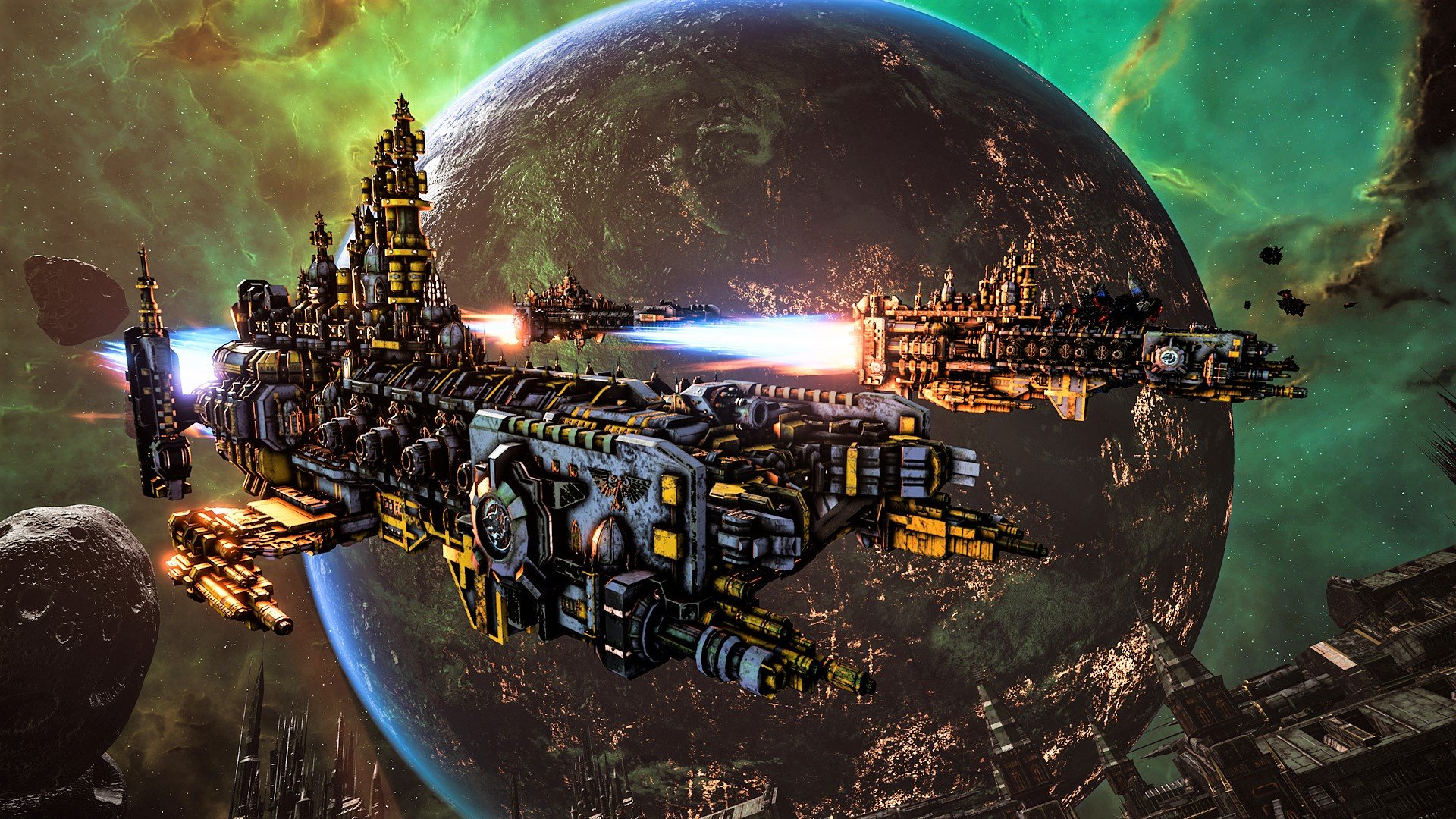
Battlefleet Gothic: Armada 2 (2019)
Tindalos Interactive / Focus Home Entertainment
In the grim darkness of the 41st millennium, there is only war. But the vast majority of 40k games tend to focus on ‘grounded’ fighting, whether that be on the surface of embattled planets, inside the tossing, red-lit corridors of a freshly-boarded warship, or deep within the pitch-dark, drifting belly of a Space Hulk.
Not so amid the cosmic naval warfare of Battlefleet Gothic, first launched as a spaceship fleet-based miniatures game in 1999, and revived for PC by developer Tindalos in 2016, three years after the dwindling tabletop line was finally canned by Games Workshop; and the 2019 sequel is the best execution of strategic void warfare yet.
You take command of a flotilla of 40k’s preposterous spacefaring warships: colossal, flying gothic cathedrals with more buttresses, spires, and crenellations than a small European city. You’ll through fleet-on-fleet battles on a fixed horizontal plane, against vessels from a selection of humanity’s many deadly enemies.
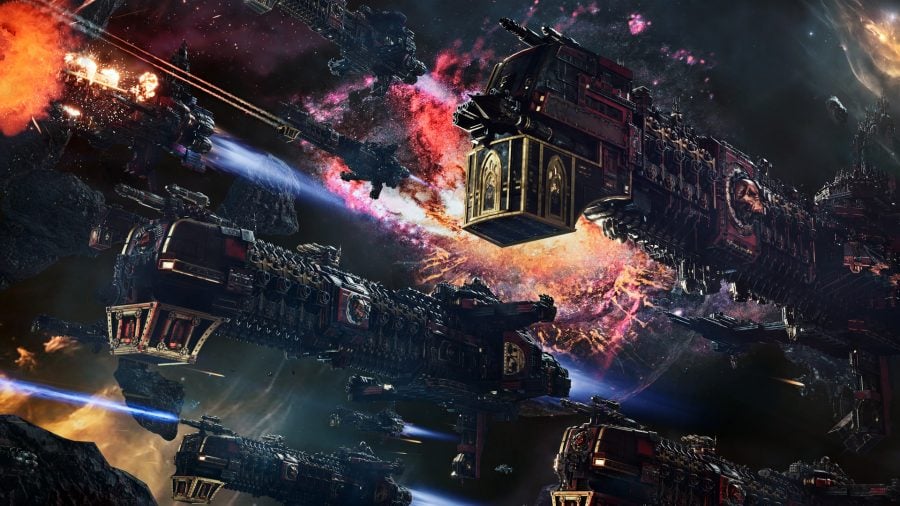
On top of that, there are three fully fledged campaigns in the base game. There’s a certain level of 4x gameplay here, as you secure control over different systems and muster your armies, and while the Imperial campaign is the ‘default’, the Tyranid Hive Fleets and robotic Necrons both offer very interesting variants. The strategic value of a planet if fundamentally different when all you want to do is eat it, after all.
With their slow turning circles and prow-mounted broadsides, there’s a lot in common between the Imperial Navy and 19th century ships of the line. But the many Warhammer 40k factions wage war in the void in starkly different ways, from the nimble and fragile Aeldari to the ram-fronted Ork ships, and as well as the three campaign factions there are loads more to tussle with in multiplayer or skirmish mode.
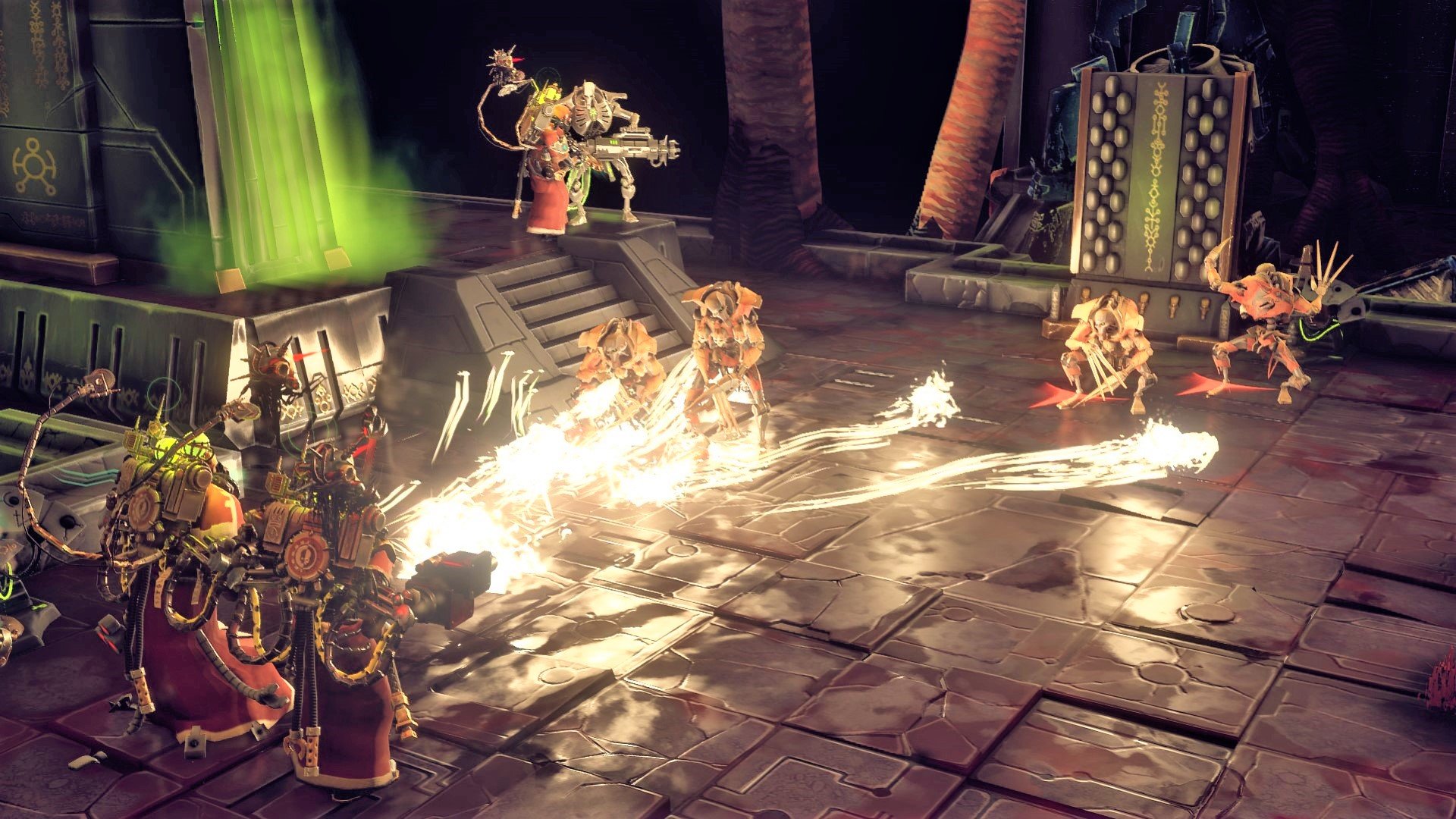
Mechanicus (2018)
Bulwark Studios / Casedo Games
The Adeptus Mechanicus is a faction of technology-worshipping cyborg mystics from Mars, whose prevailing mission is to amass hoards of technological wisdom and understanding – primarily by scouring the galaxy for rare, complex or esoteric gadgets, stealing them, and taking them home to tinker with in the garage for the rest of time.
This, in a nutshell, is the plot of Kasedo Games’ 2018 turn-based tactical squad battler, Mechanicus. You take command of a small but growing squad of Adeptus Mechanicus tech-priests, tasked with exploring worlds in search of hi-tech plunder. Sofar, so good.
Once you get down to the surface, though, things start getting all spooky, geometric, green, and glowing real fast. Those subterranean treasure vaults you saw on the scanners were, it seems, actually stasis crypts full of Necrons – soulless, ancient robotic killers – and they are none too pleased to be woken up by a bunch of half-organic grave robbers trying to nick their laptops.
So begins your distinctly XCOM-inspired progression through a series of increasingly challenging – but quite similar – grid-based maps, carefully managing your tech-priests’ limited action points to complete objectives, while avoiding vaporisation in the neon green beams of Necron gauss weapons.
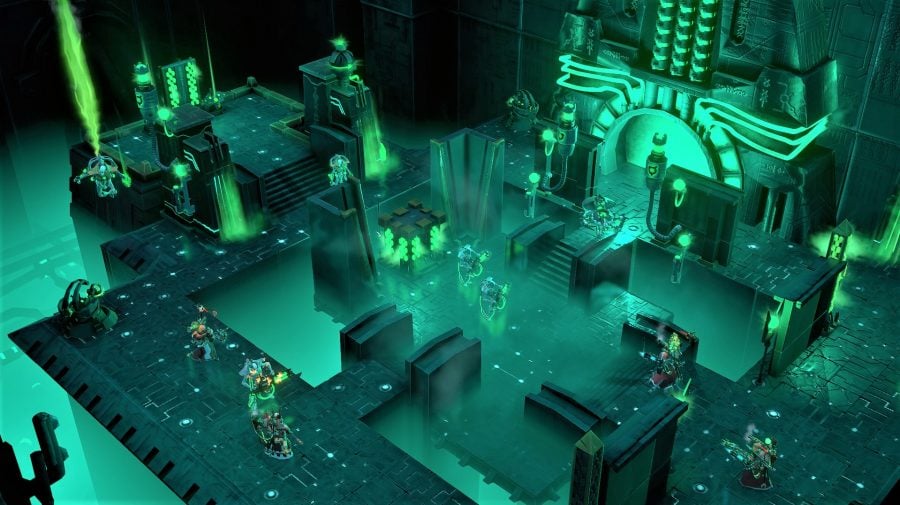
Mechanicus is here in no small part because of its strikingly faithful, vivid, and unapologetically weird portrayal of the Adeptus Mechanicus – a lovably eccentric but fairly high-concept sci-fi faction that it would have been so easy to deal with in a half-arsed way.
From the characters’ campy, cyborg-ish names made up of jumbled numerals and Greek letters, down to the fizzling data-blurts of their part-sonic, part digital language, Kasedo did the AdMech properly.
If you like the sound of XCOM-like gameplay with a few smart twists, a surprisingly excellent narrative, battling cyber-mummies in a dusty crypt, and having USB sticks for fingers, this is the one for you.
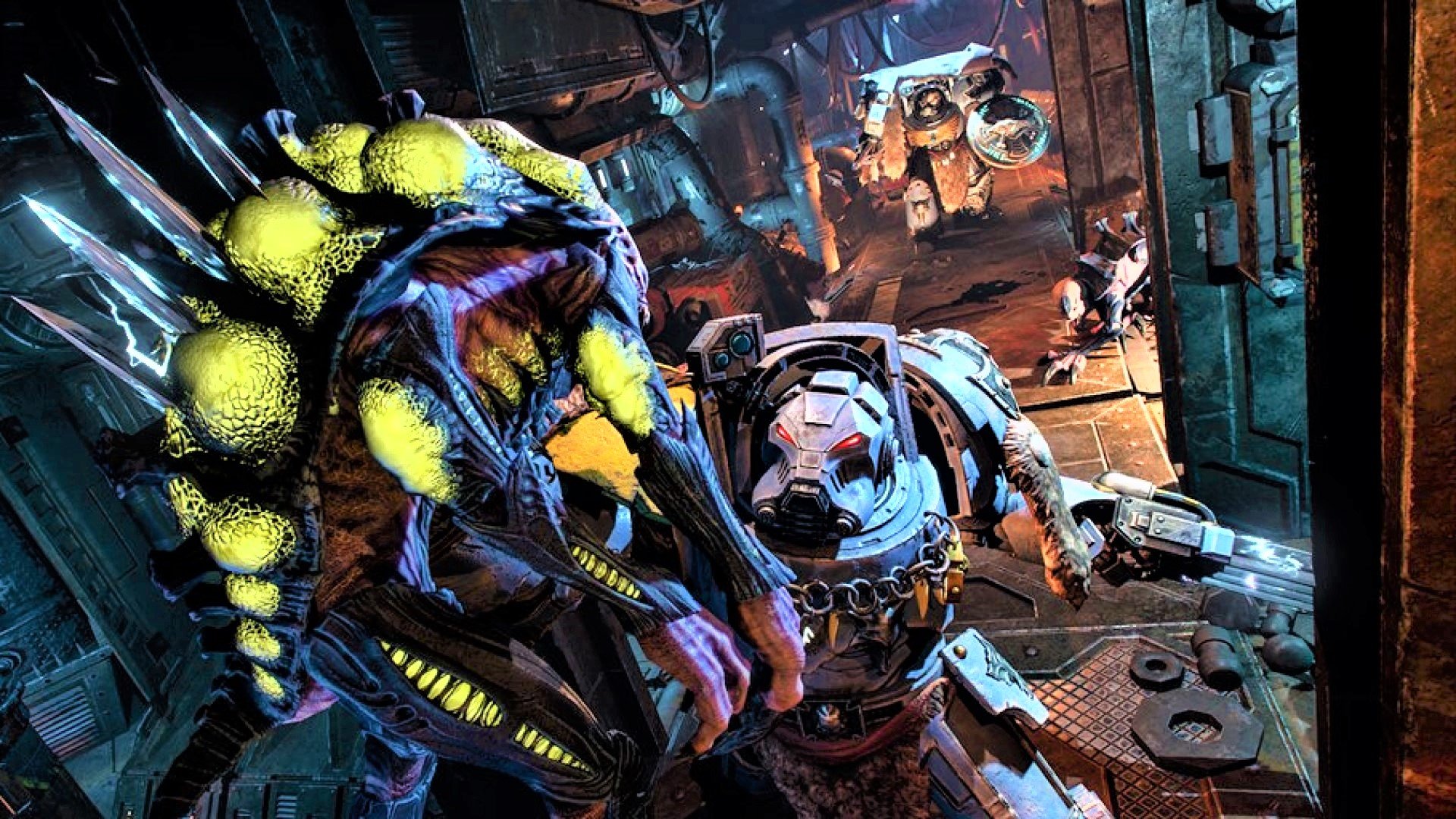
Space Hulk: Tactics (2018)
Cyanide / Focus Entertainment
Games Workshop’s original Space Hulk board game released in 1989 to some acclaim, pitting the Space Marines’ elite Terminator warriors against scythe-clawed alien fiends in a lightless, terrifying cosmic shipwreck. It was “heavily inspired by” (lovingly riped-off from) James Cameron’s Aliens, translated into the 40k setting, and in that regard was an absolute success.
Subsequent editions in 1996, 2009, and 2014 sold well to a growing cult audience, especially 2014’s fourth edition, which arrived at the very start of Warhammer’s recent rennaissance. Space Hulk on the tabletop, therefore, has earned its place as one of Warhammer 40k’s most distinguished and popular games. The digital adaptations? Not so much.
There are no fewer than eight videogames bearing the Space Hulk name (if you count its 2005 outing on the Nokia N-Gage), but none has made an impact anywhere near the scale of their board-based grandpappy – none, that is, except developer Cyanide’s breakout 2018 adaptation, Space Hulk: Tactics.
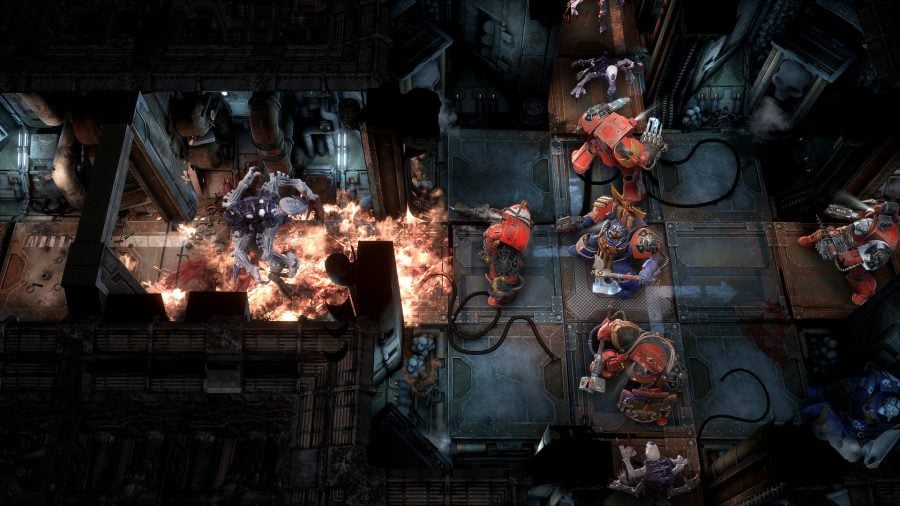
The core of Tactics is a direct remake of the board game, adding the characterful and well-observed 3D graphics to turn out a perfectly portable PC and console port. Around that core is a new system of cards with which further customise your chosen team of Blood Angels’ abilities, and hopefully turn the tide of battle at the game’s crucial moments.
Add to that the twin campaigns – one seeing you control the Blood Angel Space Marines against the Genestealers, the other flipping the table to control the ‘Nids against Ultramarines Astartes centuries earlier on the same ship. It’s a single-player feast.
If you like 40K, slick digital board game adaptations, and spending multiple hours scant grid squares away from slavering alien bioweapons that want to eat your organs, you’re in the right place. Recommended.
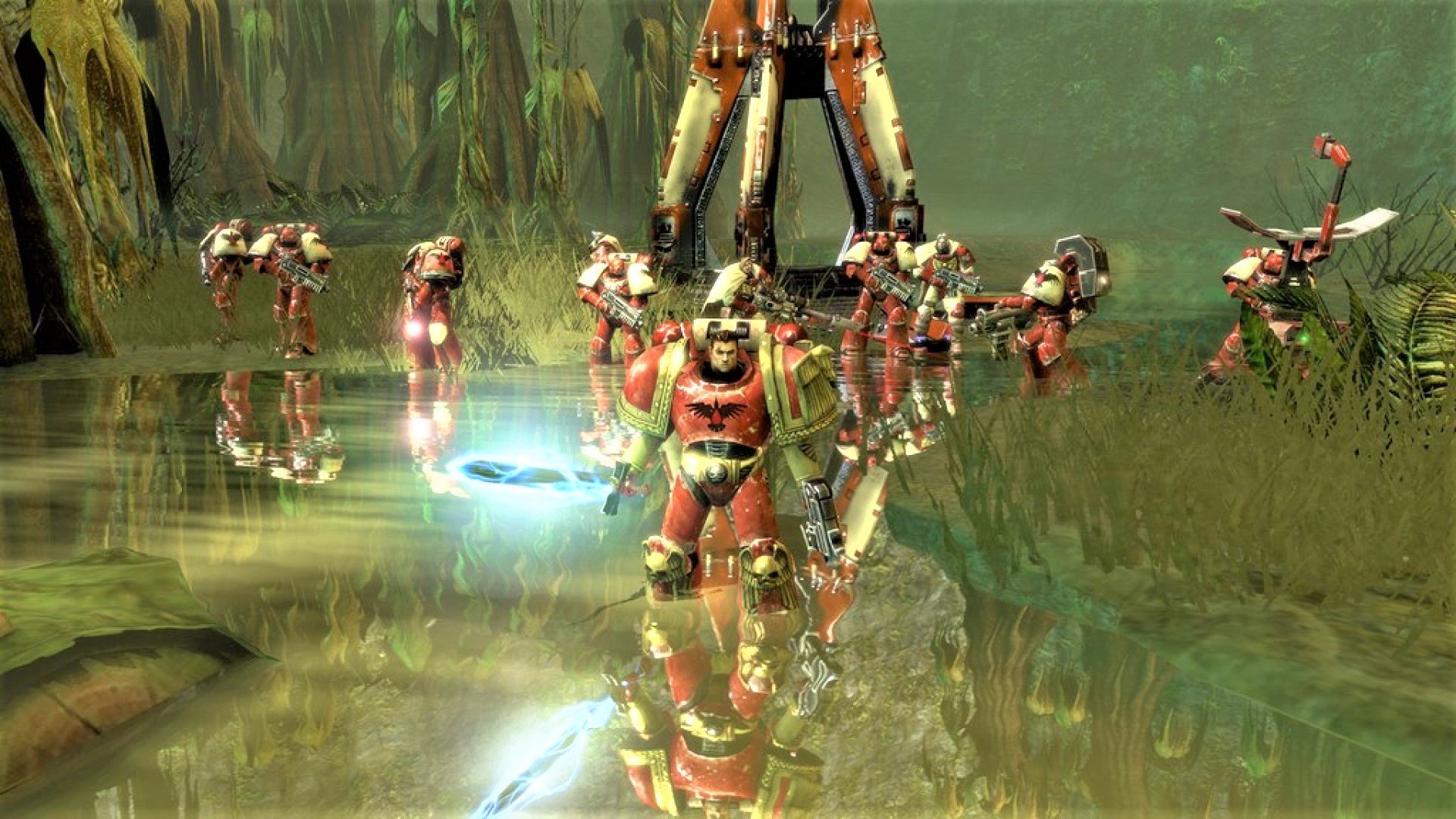
Dawn of War 2 (2009)
Relic Entertainment / THQ
In every Warhammer 40k videogames thread, a divide quickly forms between those reformists who prefer the squad-level, RPG-inspired narrative campaigns of Dawn of War 2, and the base-building competitive RTS purists, for whom the OG Dawn of War is a masterpiece, and the sequel an ill-considered damp squib.
Both the original Dawn of Wars are superb in their own right – but each lends itself to a very different style of play, and aims to create different kinds of experience for the player.
Dawn of War 2 distils, streamlines, nips and tucks the original to create an altogether different beast. Sprawling, wide-open maps are squeezed down into graphically lusher, but completely linear, railroaded environments.
The quickly-snowballing hordes of units you once flung across the map with abandon are replaced with just a couple of persistent squads, led by named characters, with RPG-like equipment upgrades, and skill progression mechanics. Base-building is all but erased from the game, buildings reduced to inert terrain pieces from which to respawn your (very limited) support units, should they fall.
But, despite what the Dawn of War 1 purists say, in this case, less is in many ways more. DoW2’s narrower focus gives it more room to expand from the original’s faithful, yet somewhat superficial portrayal of the 40K universe, baking more detailed storytelling, character interactions and dialogue into the mission-to-mission gameplay, rather than just CGI cutscenes.
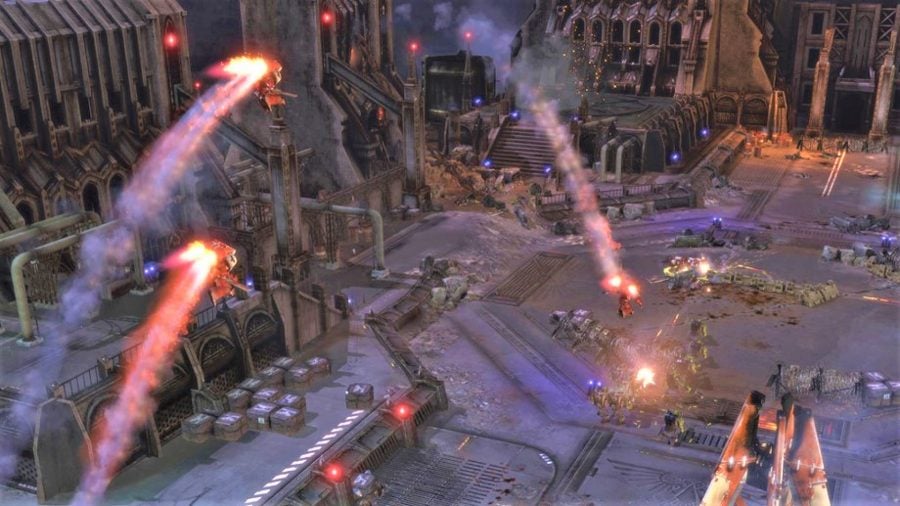
You’re able to select from a choice of squads to take on each sortie, decking each out with different wargear and skills each time to mix up their in-game tactics, and finding out what works best for you, which – frankly – is a whole ton of fun.
It’ll soon have you picking your favourite squads over others, getting a feel for their abilities, their tactical utility, their weaknesses, and their leaders’ occasional witty banter, both on- and off-mission. This draws you into the game’s storytelling in a way that’s entwined with the gameplay, rather than tacked awkwardly onto it, as is so often the case in classic RTS campaigns.
We could go on for pages about the innovative storytelling in DoWII, its beautifully-constructed missions, and the ingenious, maddeningly addictive and shockingly ahead-of-its-time Last Stand horde mode, but, honestly, your time would be better spent just playing the game. Just go and get it, right now. We mean it.
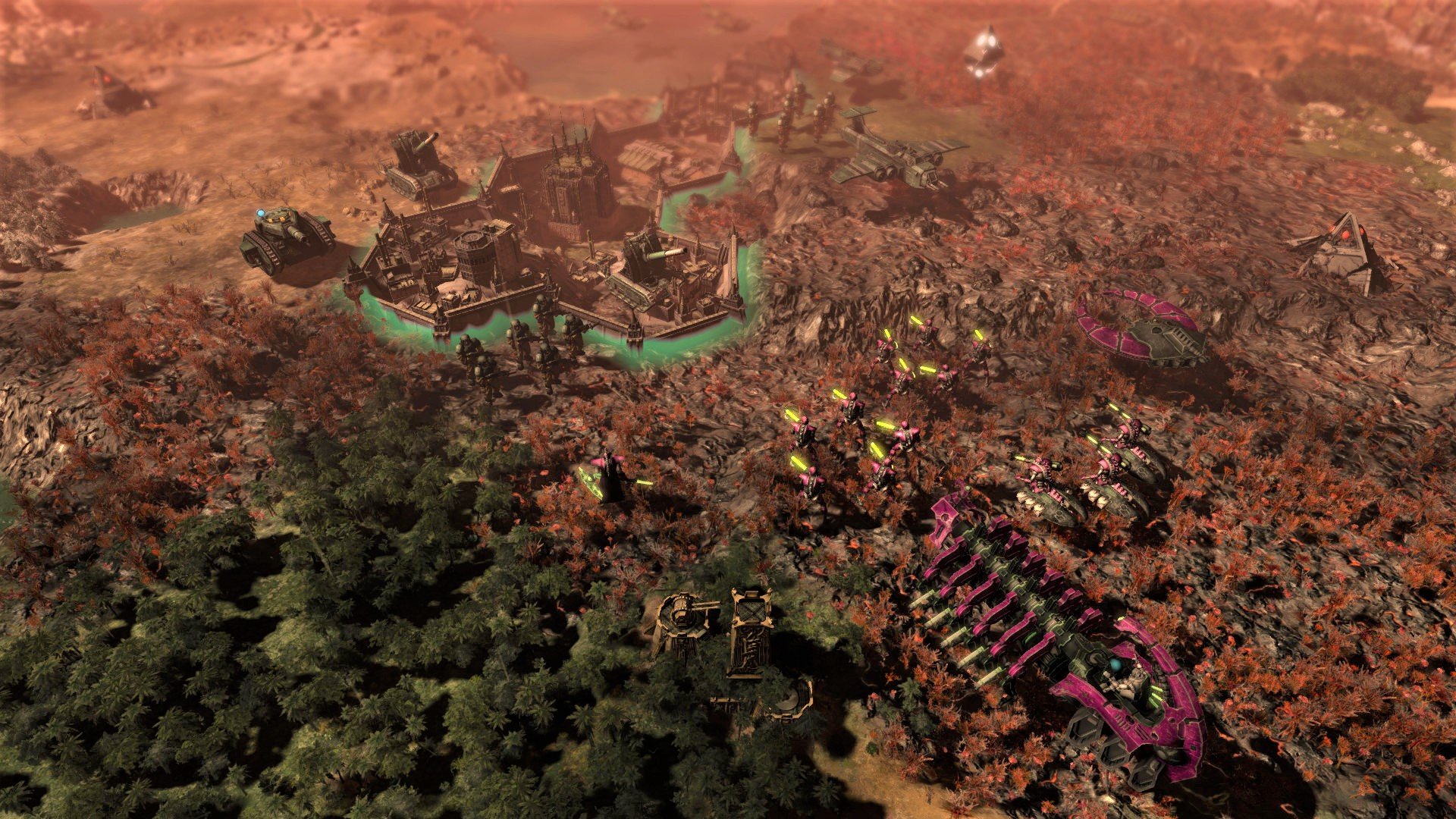
Gladius – Relics of War (2018)
Proxy Studios / Slitherine Studios
Where Warhammer 40k the tabletop miniature wargame puts you in charge of an army, Gladius – Relics of War puts you in charge of a complete military industrial complex. It’s the only Warhammer 40k 4X game so far.
If you’ve not heard of 4X, it stands for Explore, Expand, Exploit and Exterminate – your four key tasks as you establish, then grow, your 41st-millennium planetary empire, developing cities and training stacks of Necron Warriors or Tactical Space Marine units just as you might Spearmen or Archers in a game of Sid Meier’s Civilization VI.
The city-settling, infrastructure-building, ‘one more turn’ model of strategy is a slightly odd fit for the violence-first world of Warhammer 40k.
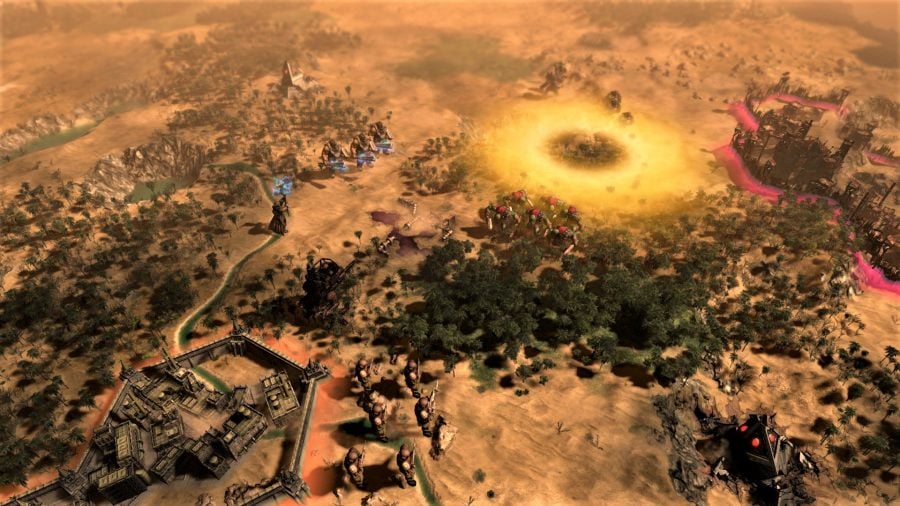
But, on the whole, Gladius works surprisingly well. The visuals are gorgeous, if let down by some unremarkable and slightly immersion-breaking janky animations (it ain’t no Civ in that department) and, while those hoping for hardcore wargame levels of mechanical depth will come away hungry, there’s enough meat to the factions’ tech trees and progression to provide a respectable, if quite easy-going strategy package overall.
Gladius has a surprising amount in common with Endless Legends. Similarly to that game, the map is divided into regions, each of which can support one city – less free-wheeling than Civ, and one that makes the founding (or conquest) of a city a particularly big deal. As a city grows it will expand into neighbouring hexes, eating up their resources and producing specialised nodes. The birds-eye view of tiny 40k cityscapes is a treat – as it blowing them up.
If you’re a 40k fan who cut their strategy gaming teeth on Civilization (on a lower difficulty setting, at least) don’t sleep on Gladius; there’s a lot of fun to be had here.
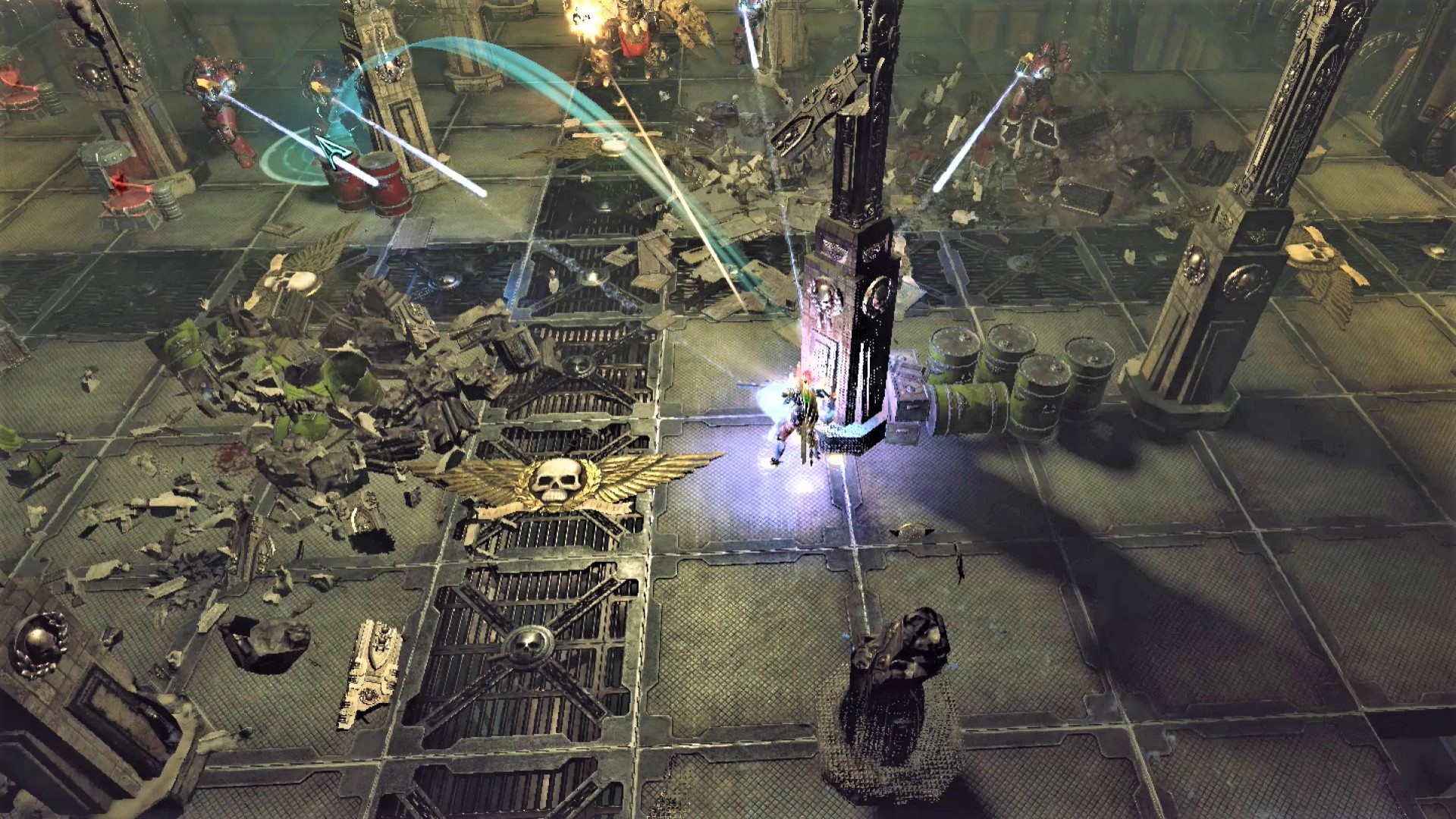
Inquisitor: Martyr (2017)
NeoCore Games
Inquisitor: Martyr casts you as an agent of the Imperium’s shadowy, pseudo-religious, paramilitary secret police force, the Holy Inquisition. Arriving aboard a benighted space station to investigate some suspicious signals, you’ll soon embark on a broader quest that sees you travel to other parts of 40k’s grim, dark galaxy.
In a manner very familiar to anyone who’s played more than ten minutes of Diablo or Path of Exile, you’ll gather up shiploads of weapons, gear, upgrades, and consumables from your enemies’ mortal remains, upgrading your loadout by equipping the cream of the crop, and recycling all the rest.
There’s more than enough abilities to unlock and try out, arranged in three different class trees (shooty, stabby or psyker) to encourage multiple playthroughs and different character builds. While there are similar content seasons to Path of Exile or Diablo IV, and plenty of extra build options thanks to DLC, this game isn’t a standout in its genre – though if you want a deeply enthusiastic take on it, check out the video by YouTuber Cheeser.

But it gets the basics right, and has some fun ideas. A lot of thought has gone into making ranged combat genuinely interesting in an ARPG, and a dedicated cover system, and mechanics for suppression fire, do a lot to distinguish it from its peers. While it’s always true that multiplayer games are better with friends, that’s especially true here, because a party with mixed abilities will let you enjoy your specialisation to the fullest.
If you’re a 40k fan who fancies some Diablo-like action, or a Path of Exile grinder who’s on a bit of a 40k kick at the moment, this is definitely worth a look. It’s regularly on sale, so we don’t advise buying it for label price.
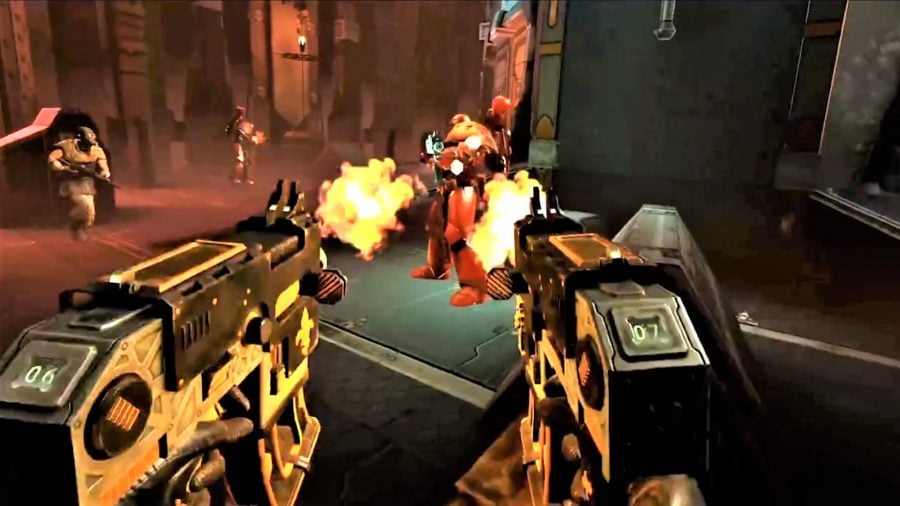
Battle Sister (2022)
Soul Assembly Ltd.
Virtual-reality shooter Battle Sister, from developer Pixel Toys, does have some flaws. It was made on a budget, and like many VR titles, it’s pretty short, and its on-the-rails FPS gunplay is made to feel all the more perfunctory, at times, by some extremely basic AI.
Depending on their weaponry, enemies will tend to either stand stock still and take potshots at you from cover, or rush directly into your face, with little in between. The story is nothing to write home about, either, and neither your Adepta Sororitas battle-nun protagonist Sister Ophelia, nor your primary in-game ally (a Black Templars-chapter Space Marine) gives you much reason to care about them.
Nevertheless, the title deserves its spot on this list because – and we can’t stress this enough – it’s a properly functioning Warhammer 40k shooter in VR, that really exists, that you can buy and play, today, on earth. Let that sink in for a moment.

Though all the fundamentals of the game may be middle of the road, the sheer thrill of a game that, more than any pancake monitor screen, allows you to truly hold the grip of that boltgun, flamer, or meltagun as you empty its ammo into a shrieking Chaos daemon two feet from your face; a game that has your arm drive the fizzling power sword blade hilt-deep into that Chaos Space Marine’s horned faceplate – there’s absolutely nothing else like it.
Siblings, don your thrice-blessed Oculus headset, and scream your battlecry so the Emperor himself can hear you (and you trigger the game’s voice-activated special powers). This is Warhammer 40k videogaming at its very realest.
Whew! If that’s not enough Warhammer 40k goodness for you, check out our lore guides to all the Warhammer 40k factions.
